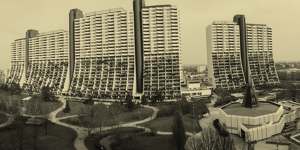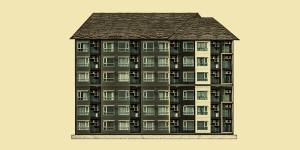In one critical way,though,the Austrian capital is completely different to Australia’s major cities. In Vienna,around half the population lives in public housing. TheseGemeindebauten(“municipal housing”) are modest apartments in high-density neighbourhoods with space for growing families and shared facilities such as rooftop swimming pools. They are close to child care,transport,schools and work. Rents are capped at a reasonable fraction of household income. Tenure can be for life.
For many Viennese,then,housing isn’t a worry. Buying a flat is within their reach but there’s no pressure to;indeed,if their wage grows faster than their rent,they might be better off never owning at all. In Australia,meanwhile,we fret – about hard-won deposits,soaring rents,crippling mortgages,capital gains,negative gearing,competing for a lease,evictions and heartless landlords.
We hear of a “housing crisis”,of a younger generation shut out of the market by a lack of supply,soaring prices and a tax system unfairly favouring (invariably older) investors;and in which waiting lists are impossibly long for public,social and “affordable” housing.
“This will take decades to sort out,” says Michael Fotheringham,managing director of the Australian Housing and Urban Research Institute. “Trying to fix housing in three or five years is just not going to happen. We need to think longer,and we need to have a stable,long-term plan to make it work.” But exactly what that plan should be is contentious.
How did we get ourselves in such a pickle? How do other countries manage so much better? What’s the solution?

The Alterlaa residences in Vienna,built in the ’70s and ’80s.Wikicommons,digitally tinted
First,how do we know we have a problem?
A housing crisis is not a modern phenomenon. “Authoritative statements at the weekend dashed any hopes of a quick end to the housing shortage,” said Queensland’s Courier Mail… in 1950. In 1975,The Canberra Times bemoaned “the worst crisis in rental accommodation in Canberra’s recent history”. In a 1980 article about “rocketing property values and rents” in inner Sydney,a vicar told the SydneyTribune “this invasion of the well-to-do,both homeowners and property speculators,is resulting in an angry,divided,violent community”.
Experts generally agree the current “crisis” began to manifest in the 1990s. “That’s when house prices really started to detach from wages and that equation of how much income you need to be able to buy a house started to really break apart,” says Joey Moloney,the deputy program director of the Grattan Institute’s Housing and Economic Security program.
“When house prices are running away from you,even the most disciplined savings behaviour might not be enough. And we’ve got this other acute problem of a really tight rental market. If you’re not living with your parents,every dollar that you have to put towards the rent is a dollar less that you get to put towards your house deposit.”

Housing affordability is typically measured by comparing income against housing costs. As the average proportion of income required to service a mortgage,or to pay rent,increases,housing moves toward being “unaffordable”. The figures show this is,indeed,the situation across much of Australia.
As independent economist Chris Richardson put it,“Australian house prices are harder to kill than John Wick” (referring to the title character of a movie about a highly resilient hitman). Not even the pandemic or 13 interest rate increases in a row could do it.
calculates that a household earning the median income in Australia could,as of June 2023,have afforded just 13 per cent of homes sold across the country – the lowest share since records started in 1995.
That’s just part of the picture. “Most people focus on the price of the house but this is short-sighted,” observed a federal government inquiry in 2021,chaired by then-member of parliament. “The largest barrier to entry for young Australians is saving for the deposit.” According to Federal Treasury,the average time it takes to save a 20 per cent house deposit reached almost 11.4 years during the first three months of 2024 compared to about six in 2002.

What’s clear is that housing is being pushed further out of reach for each generation. About 38 per cent of people born between 1987 and 1991 own a home,according to the Australian Housing and Urban Research Institute,compared to 58 per cent of people born between 1947 and 1951 – Baby boomers – who owned their own house by the same age.

Renting is increasingly challenging too. Capital city rents saw the biggest annual increase for 15 years to the end of March,.,from March,shows rental affordability in Australia is the worst it’s ever been,with just over one in 10 rental listings affordable for a family of four with both parents on the full-time minimum wage.
A 2023 found that the state’s rental market was being “squeezed” by two groups of people in particular. First,middle‑ and high‑income earners who in the past would have been homeowners but who don’t have the funds or inclination,so are renting;and low‑income earners seeking rentals who would otherwise be in social housing if it was available to them.
(Social housing refers to both community housing,owned or managed by not-for-profit providers,and public housing,which is government-owned. People eligible for public housing are on low incomes or unemployed,living with a disability or a mental illness,or at risk of homelessness. They are also eligible for community housing;and so are others on higher incomes.)
The bottom line is that,by any measure,housing affordability has deteriorated sharply.

A group of prospective renters wait to view a property in Sydney.Flavio Brancaleone,digitally tinted
Who or what is to blame?
In 1953,a letter writer toThe Sydney Morning Herald blamed that era’s housing crisis on building workers “loafing on the job”. This,he contended,“coupled with the 40-hour week,is the reason for home shortages”.
It’s a little more complex than that – as the Falinski Inquiry noted. Its report described housing affordability and supply in Australia as a “Gordian Knot of oppressive regulation,muddle-headed central planning,officious big state regulation and the skinning of new home buyers via a myriad of taxes and charges designed to raise funds not living standards”.
The inquiry suggested there were two opposing “camps”. The first camp believed the problem,largely,was a tax system that encouraged speculation in property investment – those often-maligned Baby Boomers who own multiple rentals. The second tribe believed it was poor planning of supply that was primarily to blame,along with government intervention that had “materially damaged home ownership in Australia”.
Talk to the property industry today – including builders and developers – and they’ll tell you excessive government regulation,overbearing local councils,onerous planning rules and high state government taxes are mostly to blame.
High stamp duty,in some states,is a case in point. Once a relatively small sum,since it is calculated as a proportion of the house price,it can now be onerous,thanks to the strong rise in prices. Faced with this,even would-be downsizers,who might have sold their family homes to the next generation,are opting to stay put because the transactional cost of buying something,even if it’s smaller,seems unreasonable.
On the other hand,many economists,planners,academics and social welfare advocates will tell you the federal tax system is a big issue:that capital gains tax concessions and negative gearing rules have combined to distort the market by turning housing into a tax-minimisation vehicle. (More on that shortly.)
’There are not enough homes being built in the right areas to meet the needs of our communities.”
Another factor is migration. While appropriate levels are a perennially contested area of debate,it’s generally agreed our economy and ageing population depend on new arrivals to maintain our standard of living. Yet migration,by definition,adds to demand for some things,including housing,says the Grattan Institute’s Moloney. “If you’ve got more people,then that’s more people that you need to house.”
Bottom line:supply of houses is the number one factor,say state and federal governments. “There are not enough homes being built in the right areas to meet the needs of our communities,” the Federal Treasury said in this year’s budget.
Treasury points out Australia has among the lowest number of homes as a proportion of the population in the developed world. (This is most dire in Perth,where a combination of a slowdown in new builds and existing owners not moving plus positive net migration into the state has led to nearly a quarter fewer houses for sale compared to the same time last year.) According to Reserve Bank analysis,every 1 per cent increase in the Australian housing stock would gradually cut prices and rents by about 2.5 per cent.
The reasons we don’t build enough homes are hotly debated. The Treasury says the problem has been exacerbated by a lack of essential infrastructure in greenfield developments,a critical shortage of skilled labour and falling productivity in the sector,as well as cumbersome land release and zoning rules.
RMIT Emeritus Professor David Hayward also points to a shortage of social and affordable housing,which leads to increased demand for private rentals from those who might otherwise have been housed by the state. NSW,for example,has a shortfall of 200,000 social and affordable homes,according to Homelessness NSW. “Australia has just abandoned the notion,” says Greens housing spokesperson Max Chandler-Mather,“that[housing] should be something that the government plays a big role in ensuring everyone has access to.”
The way we live makes a difference,too. Household sizes are shrinking – there are fewer people per room.,Reserve Bank Assistant Governor Sarah Hunter pointed out that there are about 27 million people who live in Australia,in about 11 million households. The average number of people living in each household has trended lower,from around 2.8 in the mid-1980s to around 2.5. This seemingly small change has had a massive impact. If,for some reason,the average household size rose back to 2.8,Australia would need 1.2 million fewer dwellings to house our current population. “No small difference,” Hunter said.

Independent federal MPS Kylea Tink and David Pocock propose that housing be viewed as a human right.Alex Ellinghausen,digitally tinted
What role does negative gearing play?
Negative gearing,in a nutshell,is when expenses on an investment property (such as mortgage payments) outweigh the rental income being earned,and the owner incurs a loss. But under Australia’s tax system,people who are “negatively geared” in property can deduct their rental losses from other taxable income,such as salary and wages,resulting in a lower overall tax bill.
Combined with a capital gains tax discount,negative gearing is the most contentious issue in housing policy. Many,including the Greens and the,want to wind it back or get rid of it entirely. The government has not flagged any plan to change current policy and the Coalition supports keeping it.
Running an investment property at a loss might seem silly. Yet plenty of people have been keen to do it – and simultaneously with multiple properties. This is at least partly because of the generous way we tax capital gains today,a function of a rule change in 1999 by the Howard government on how profit from investments (such as shares and property) was taxed. The new rules said that if you held an asset for 12 months or longer,when it came time to sell,you would be taxed only on half the profit. In other words,if you sold an investment property and made a profit of,say $100,000,you paid tax on only $50,000.
Some argue getting rid of negative gearing would further tighten the rental market … others argue it would be a zero-sum game where landlords would be replaced by first home buyers.
This change turbocharged investor interest in property. “The interaction of negative gearing and tax concessions for capital gains provides some investors with a sizeable tax advantage,” noted the,adding that “tax deductions from wage income may also generate a ‘psychic pay-off’ for some investors – the pleasure of an immediate reduction in tax.”
Those rules put first home buyers (indeed,all owner-occupiers) in a different financial position to investors,who can treat homes as liquid assets and tenants as transitory. Some argue getting rid of negative gearing would further tighten the rental market because investors would opt out. In response,others argue it would be a zero-sum game where landlords would be replaced by first home buyers.
Michael Fotheringham suggests reining in negative gearing and capital gains tax concessions might help prospective buyers who otherwise would be competing with investors. On the other hand,fewer investors would mean fewer rental properties. “Now supplying rental stock is important – we’ve got lots of renters,it’s a growth market.”

A public residential block in Singapore where most people own their own government-built flat.Getty Images
Why don’t we just build more homes?
We’ve been here before. After World War II,returning troops and new migrants contributed to a housing shortage that the Menzies government combated with schemes to encourage new builds,including removing the sales tax on building materials and creating grants to help young couples save for a deposit.
Between 1947 and 1971 the total stock of dwellings in Australia increased from just under two million to over four million,according to the Robert Menzies Institute. Many of these homes were freestanding and suburban,on their own patch of dirt – the Australian dream.
Other countries,facing a similar housing shortage,have gone down a different path:higher density. South Korea has its vastapatu danji – apartment complexes – originally a rapidly deployed post-war solution and now where many Koreans live,in high-rises from 12 to 50 storeys.
Athens has itspolikatoikia (condominiums):balconied concrete mid-rise apartment blocks thrown up in a hurry from the 1950s to the 1980s to serve a city “with urgent housing needs and little money to spend”,observes Bloomberg’s. “They may lack the elegance of Athens’ earlier neoclassical housing but they have helped to create a city that is vibrant,socially integrated and (until recently) affordable.”
Then there are the two cities most often held up as successful exponents of government-led housing schemes:Vienna,where it’s commonplace to live in rent-controlled public estates,and Singapore,where a mandatory savings program has turned its citizens into a nation of (high-density) homeowners.
‘You look at Europe,three-bedroom,four-bedroom apartments are relatively common. Your typical German family is raising a couple of kids in an apartment.’
Vienna began building itsGemeindebautenduring a housing crisis after the end of World War I. The aim was always to encourage a diverse community of flat dwellers,both on social benefits and not. To qualify for a rental apartment today,you must be over 17,have lived in the city for the past two years and not breach an initial income cap:criteria that capture some 80 per cent of residents.
Singapore’s flat-dwellers are homeowners – – most living in complexes built by the government’s Housing Development Board. Fewer than 5 per cent live in homes on their own land. This is a direct consequence of a massive building program,subsidies and a pension scheme that dates back to 1955,which mandates around 37 per cent of an employee’s income goes to a fund that can later be used to buy housing outright or to service a mortgage.
“You look at Europe,three-bedroom,four-bedroom apartments are relatively common,” says Moloney. “Your typical German family is raising a couple of kids in an apartment.”
Could a city such as,say,Melbourne really turn into something like Vienna? It would probably take on its own flavour,he says. “Density done well in Melbourne is probably going to look a bit different than other cities across the world.”
The Greens advocate a similar program of government-sponsored home building here. “We think the government should follow what Australia did in the past and what heaps of European countries do,” says Max Chandler-Mather. “The quality of housing,say in Vienna,is a lot higher because the government plays a bigger role in the supply of affordable housing.” Remember – every 1 per cent increase in the Australian housing stock would gradually cut prices and rents by about 2.5 per cent.
For its part,the federal government has allocated $32 billion to underpin the building of 1.2 million homes by the end of this decade,in both private and public sectors,a goal that federal Housing Minister Julie Collins in 2023 described as “”. It plans to achieve this,in part,by boosting infrastructure spending,funding thousands of social and affordable homes and by offering incentives to the states and territories to reform planning controls. “We are working across government,with the states and territories,the construction sector and those on the front line of our housing challenges to ensure that more Australians have a safe and affordable place to call home,” says Collins.
When the Victorian government released its last September with a plan to build 800,000 homes over a decade,former premier Daniel Andrews claimed:“It’s a simple proposition:build more homes,and they’ll be more affordable.”
Not everybody agrees it’s that easy,though. Where,for one,will these homes be built,who will build them,and what neighbourhood amenities,such as open space,schools and transport,will service them?
The City of Boroondara,a council in Melbourne’s east,has argued cogently against top-down plans to increase the supply of new housing in its jurisdiction by 300 per cent each year. “To release housing targets on the scale proposed without making any commitment to the infrastructure required to support such exceptional growth is irresponsible planning,” they say. “Our community has a right to such fundamentals as public open space,adequate drainage and sewage systems,education facilities,health services and transport networks.”
Indeed,Jason Falinski warns us today,“Every time we intervene in the market we’re creating unintended consequences all over the place. Then we try to patch it up by intervening more,which just creates more and more unintended consequences. You know,30,40,50 years on,we’ve created a diabolical mess.”

The housing problem in Australia will take decades to sort out,say experts.Getty Images,digitally tinted
What else can be done to improve affordability?
The trouble with the word “crisis” is that it wrongly implies a problem that might go away as quickly as it arrived,says Michael Fotheringham. “This will take decades to sort out,” he says.
We can all agree that we need more homes but we don’t all agree on how else we can improve affordability,especially for first-time buyers. “You want to tilt the scales for them,” says the opposition’s housing spokesperson,Andrew Bragg. “We recognise that there’s a social and economic good there.”
The federal government has its homes target and hopes to encourage new buyers into homes through its “help to buy” scheme,where a capped number of applicants enter into a shared equity arrangement (where the federal government owns part of a property,which can eventually be bought out).
Says Moloney:“If actually making that target meant that we improved the efficiency of development application processes,if we did all that heavy lifting,if we did all that reform,that really is the ultimate long-term fix to this problem.” He adds:“The ultimate long-term fix to this problem is making it easier to build more medium density in those desirable suburbs where people want to live and work. More medium-density living can lead to more vibrant neighbourhoods where everything is much more walkable,where people are less dependent on cars and that have good public transport links.”
‘Set up a public developer to go and build hundreds of thousands of good-quality apartments and homes that are then rented and sold at prices people can actually afford.’
The federal opposition has been investigating allowing first-home buyers to withdraw their super balance for a deposit and is considering a proposal to allow existing homeowners to offset their mortgage interest against their super balance. “You would make a considerable saving on your interest and you will own your house faster,” says housing spokesperson Andrew Bragg.
There are various state-based schemes and to help first homebuyers,such as one-off grants and stamp-duty concessions. These have helped some into the market but have also been criticised as fuelling urban sprawl – those “unintended consequences” again.
The Greens say getting rid of the negative gearing-capital gains tax discount “would put downward pressure on house prices”,says Chandler-Mather. “At the very least,it would slow down the increase in house prices.” The Greens also want to freeze rent increases and to make property developers allocate a proportion of affordable homes in developments for first-home owners and public housing.
“The solution to the housing crisis is not encouraging developers to build high-end apartments and homes that only property investors can afford to purchase,” says Chandler-Mather. “Set up a public developer to go and build hundreds of thousands of good-quality apartments and homes that are then rented and sold at prices people can actually afford.”
Meanwhile,independent MPs have jointly introduced a bill into the Senate and House of Representatives that would require the supply of adequate housing to be considered a human right. Its goals are similar to a strategy introduced in Canada in 2023,which aims to encourage the construction of more houses and eventually see housing costs at no more than 30 per cent of a typical income.
Pocock says the primary intention of his and Tink’s bill is to start a debate on what housing actually is – a human right,or a profit centre. We’ve seen a “patchwork approach of policies that both sides of politics told us are going to solve things but really haven’t and,and don’t,” he says. “This is really about building some consensus about what housing is for,trying to view it more as a human right and then ensuring that successive governments are held to account working towards that. Do we really want to live in a country where the only way that you can own your own home is by having wealthy parents? That’s sort of where we’re at.”
Get fascinating insights and explanations on the world’s most perplexing topics..